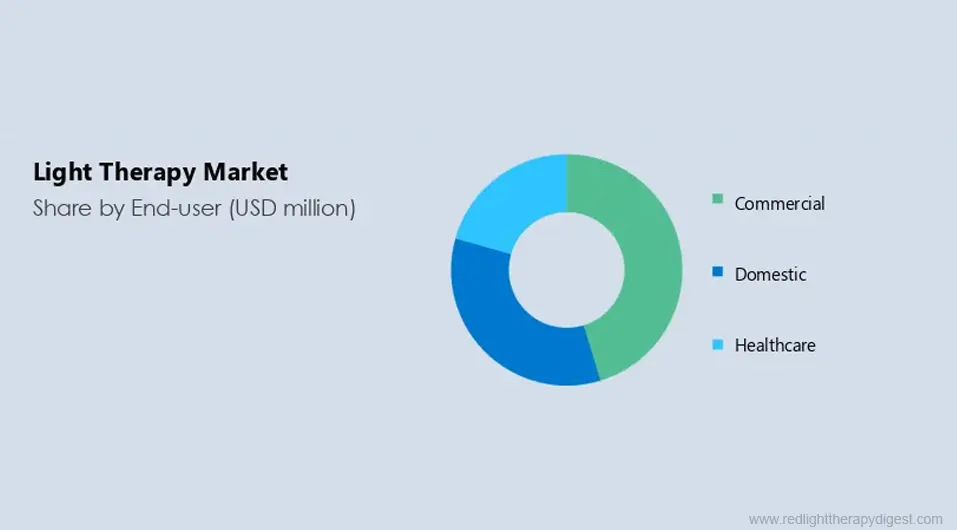The Economic Backdrop
The Present Dilemma:
Navigating through the labyrinth of rising healthcare costs, American families are feeling the pinch. The numbers don’t lie—medical expenses have ballooned, outstripping both inflation and wage increases. It’s a financial highwire act, with household budgets on the line.
The Financial Landscape:
In the economic tug-of-war, Red Light Therapy (RLT) stands out as a promising contender. Amidst a bearish market trend, the light therapy sector projects a bullish compound annual growth rate (CAGR) of 4.72% through 2027. It’s a glimmer of growth in an otherwise dim economy.
 Annual Growth Rate of Light Therapy
Annual Growth Rate of Light TherapyThe Drivers of Change: Why Light Therapy?
Aging America: As the baby boomer generation tips into retirement, the demand for gentle, non-invasive treatments is skyrocketing. With one in five Americans reaching retirement age by 2030, the healthcare system braces for a seismic shift.
Chronic Concerns: Over 133 million individuals in the U.S. wrestle with chronic illnesses, creating a pressing need for sustainable treatment options. Enter RLT—a long-term, non-pharmaceutical approach.
Tech-Savvy Solutions: Today’s population is more tech-adept than ever, and the integration of health technologies into home settings is on the rise. RLT fits neatly into this trend, offering a high-tech yet simple solution.
Pandemic Patterns: COVID-19 has altered lifestyles, pushing people indoors and amplifying interest in alternative health practices. As mental health takes center stage, RLT steps up as a versatile ally.
Emerging Preferences: Handheld light therapy devices are expected to see a surge due to their user-friendliness and cost-effectiveness.
The Role of RLT in Shaping Light Therapy’s Trajectory
RLT is not just another segment in the market—it is a central pillar. Its versatility in treating a wide range of conditions makes it invaluable. Healthcare remains the prime sector for light therapy growth, driven by the rising adoption of non-invasive treatments and chronic disease prevalence.
Mental Well-being: With its calming influence, RLT is emerging as a non-drug alternative for tackling depression and anxiety, turning a soft glow into a source of solace. In Europe, light therapy is expanding rapidly, partly due to the widespread occurrence of Seasonal Affective Disorder (SAD) in Nordic countries.
Dermatological Advances: RLT is gaining traction in dermatology, with studies pointing to its potential in skin rejuvenation and anti-aging treatments. The demand for blue light therapy, useful in skin conditions like acne and psoriasis, is anticipated to rise sharply.
Athletic Recovery: The sports world is embracing RLT for its recovery benefits, finding that it can reduce inflammation and muscle fatigue, thus optimizing athletic performance.
Forecasting the Future of Light Therapy: Global Adoption
RLT is gaining significant market presence globally. The Asia-Pacific region is rapidly adopting RLT due to expanding healthcare systems, while North America leads in innovation and consumer demand.
Innovations on the Horizon:
The integration of RLT with smart technology and telehealth platforms foreshadows a revolution in healthcare accessibility and patient empowerment.
Regulatory Recognition:
With bodies like the FDA beginning to acknowledge the merits of RLT, there is a potential for a transformative change in therapeutic practices and policies.
National Health Narrative:
This story connects the larger narrative of American resourcefulness and self-help, framing RLT as a symbol of the quest for well-being and affordable healthcare rights.
Commercial Sector Growth:
Wellness facilities and spas are increasingly integrating light therapy, signaling a healthy uptick in market expansion.
Socio-Economic Implications:
RLT’s affordability and accessibility position it as an economic equalizer, potentially reducing the disparity in healthcare services and easing the load on healthcare systems.
 Market Research Light Therapy Growth 2027 | Source: prnewswire.com
Market Research Light Therapy Growth 2027 | Source: prnewswire.comStatistical Evidence: Solidifying the Case with Data
 Light Therapy Market
Light Therapy MarketEmpirical Support:
Over 50 clinical trials have validated the effectiveness of RLT, bolstering its acceptance in the medical community.
Insights from NASA:
NASA’s research into the medical applications of light has played a crucial role in demystifying and endorsing light therapy for a variety of health conditions. NASA’s research has pivoted from laser-based applications to LED technology, broadening the accessibility for non-professional use.
Perspectives from Harvard Health:
Dr. Richard S. Schwartz of Harvard Medical School highlights the value of light therapy in treating both seasonal and nonseasonal depression, with potential comparable to antidepressants and psychotherapy.
Recognized for minimal side effects, light therapy offers a viable option for sensitive populations.
Cost-Effectiveness:
RLT might reduce the dependency on medications for chronic conditions by up to 20%, which could translate into considerable cost savings.
Red Light Therapy: Shaping a New Healthcare Paradigm
The journey of American healthcare is often fraught with uncertainty, but the embrace of Light Therapy marks a pivot toward innovation and inclusivity. As we contemplate a future where health care is both high-tech and human-centered, RLT emerges as a symbol of what’s possible when affordability and cutting-edge care converge.
In a nutshell, Red Light Therapy is not just a trend; it’s a testament to the ingenuity inherent in the pursuit of wellness. As it stands, RLT is poised to become a cornerstone of an equitable health care system, offering a ray of hope to those caught in the crosshairs of economic hardship and medical need.
**This is a subjective assessment based on the strength of the available information and our estimation of efficacy.
*Result may vary. The information contained in this website is provided for general informational purposes only. No medical claims are implied in this content, and the information herein is not intended be used for self diagnosis or self treatment of any condition.
Disclosure of Material connection: Some of the links in the post above are "associate sales links." This means if you click on the link and purchase an item, we will receive commission. Regardless, we only recommend products or services which we use personally and/or believe will add value to our readers. We are disclosing this in accordance with the Federal Trade Commission's 16 CFR, Part 255: "Guides Concerning the Use of Endorsements and Testimonials."







